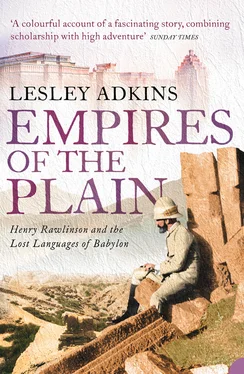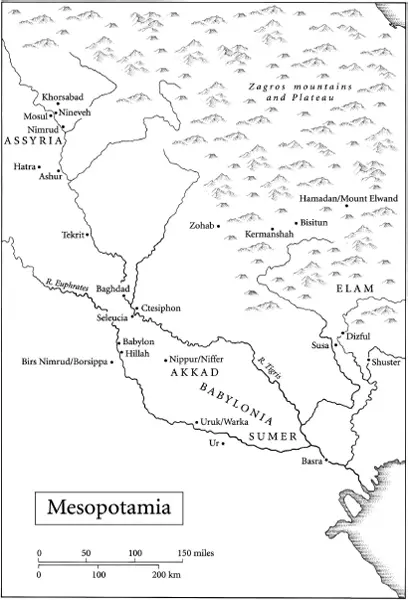The following list gives often approximate dates to show the order of events, mainly occurring in Mesopotamia and Persia:
| 8000 |
First use of clay tokens |
| 3600 |
Cylinder seals appear |
| 3500 |
Numerical clay tablets appear |
| 3300–2900 |
Proto-cuneiform clay tablets |
| 3100–2700 |
Proto-Elamite cuneiform |
| 3000–2300 |
Sumerian civilization |
| 2800 |
Sumerian is first written down (not technically as cuneiform) |
| 2600 |
Possible date for Gilgamesh as king of Uruk |
| 2600 |
Sumerian is written using a true cuneiform script |
| 2500–2000 |
Old Akkadian cuneiform |
| 2300 |
Elamite cuneiform begins |
| 2300 |
Akkadian Empire begins under King Sargon |
| 2200 |
Akkadian Empire collapses |
| 2000 |
Sumerian ceases as an everyday language |
| 2000–1600 |
Old Babylonian cuneiform |
| 2000–1500 |
Old Assyrian cuneiform |
| 1792–1750 |
Hammurabi is king of Babylon |
| 1600–1000 |
Middle Babylonian cuneiform |
| 1500–1000 |
Middle Assyrian cuneiform |
| 1400 |
Babylonian cuneiform becomes the lingua franca |
| 1235 |
Assyria sacks Babylon |
| 1115–1077 |
Tiglath-Pileser I is king of Assyria: first use of clay prisms |
| 1000–600 |
Neo-Assyrian cuneiform |
| 1000–600 |
Neo-Babylonian cuneiform |
| 930 |
Neo-Assyrian Empire begins |
| 883–859 |
Ashurnasirpal II is king of Assyria and builds a palace at Nimrud |
| 878 |
Nimrud becomes the capital city of Assyria (moved from Ashur) |
| 858–824 |
Shalmaneser III is king of Assyria and builds a new palace at Nimrud |
| 825 |
The Black Obelisk is erected at Nimrud by Shalmaneser III |
| 800 |
Aramaic language and script begin to spread in Mesopotamia and Persia |
| 753 |
Mythical foundation of Rome |
| 713 |
Sargon II of Assyria founds Khorsabad as his capital city (moved from Nimrud) |
| 704–681 |
Sennacherib is king of Assyria and moves the capital from Khorsabad to Nineveh |
| 668–627 |
Ashurbanipal is king of Assyria |
| 612 |
Nineveh is sacked: collapse of the Neo-Assyrian Empire |
| 605–562 |
Nebuchadnezzar II is king of Babylon |
| 600 BC–AD75 |
Late Babylonian cuneiform |
| 559–530 |
Cyrus the Great is king of Persia and founder of the Achaemenid dynasty |
| 555–539 |
Nabonidus is king of Babylon |
| 530–522 |
Cambyses II is king of Persia |
| 522–486 |
Darius the Great is king of Persia |
| 520 |
The Bisitun monument is started and Old Persian cuneiform is invented |
| 486–465 |
Xerxes I is king of Persia |
| 401 |
Cyrus the Younger is killed at the battle of Cunaxa |
| 336–331 |
Darius III is king of Persia |
| 333 |
Alexander the Great of Macedonia defeats Darius III at the battle of Issus |
| 331 |
Persepolis is destroyed by Alexander the Great |
| 330 |
Babylon is taken by Alexander the Great |
| 330 |
Darius III is murdered: end of the Achaemenid (Persian) Empire, which now comes under Macedonian Greek control |
| 323 |
Alexander the Great dies at Babylon |
| 238 |
The Parthians (nomads from central Asia) begin to take over the former Persian Empire |
| 141 |
Seleucia on the Tigris is taken by the Parthians |
| 75 |
The last known use of cuneiform (at Babylon) |
| 224 |
Sasanians conquer the Parthian Empire |
| 240 |
Shapur I becomes the second ruler of the Sasanian Empire |
| 260 |
The Roman emperor Valerian is captured by the Sasanians |
| 594–628 |
Khusro II is ruler of the Sasanian Empire |
| 651 |
The Sasanian Empire falls to the Arabs |
| 762 |
Baghdad is founded by al-Mansur |
| 1258 |
Baghdad falls to the Mongols |
| 1299 |
Beginning of the Ottoman Empire |
| 1588–1629 |
Shah Abbas I is ruler of Persia |
| 1600 |
The East India Company is formed |
| 1602 |
Cuneiform is observed for the first time at Persepolis |
| 1623 |
Shah Abbas I of Persia captures Baghdad |
| 1638 |
Baghdad is taken by Murad IV of the Ottoman Empire |
| 1661 |
Bombay is ceded to Britain by Portugal |
| 1722 |
Afghans besiege Isfahan |
| 1789 |
Tehran becomes the capital of Persia |
| 1792 |
Edward Hincks is born |
| 1798–1834 |
Fath Ali is Shah of Persia |
| 1802 |
The first cuneiform decipherment by Grotefend |
| 1810 |
Henry Rawlinson is born |
| 1815 |
Battle of Waterloo (final defeat of Napoleon) |
| 1817 |
Austen Henry Layard is born |
| 1827 |
Rawlinson goes to India |
| 1829 |
First ascent of Mount Ararat |
| 1833 |
Rawlinson leaves India for Persia |
| 1834 |
Fath Ali Shah of Persia dies |
| 1838 |
Coronation of Queen Victoria |
| 1839 |
Layard leaves England for Ceylon |
| 1839–42 |
First Anglo-Afghan War |
| 1848 |
Revolutions in Europe |
| 1849 |
Rawlinson and Layard meet at Nimrud |
| 1849–51 |
Rawlinson is in England |
| 1855 |
Rawlinson leaves Baghdad for good and returns to England |
| 1857 |
The cuneiform competition is held |
| 1859 |
Rawlinson goes to Tehran as Envoy |
| 1860 |
Rawlinson resigns from his post at Tehran |
| 1862 |
Rawlinson marries |
| 1866 |
Hincks dies |
| 1872 |
Discovery of the Flood tablet |
| 1887 |
Discovery of the Amarna Letters |
| 1889 |
Rawlinson’s wife dies |
| 1894 |
Layard dies |
| 1895 |
Rawlinson dies |














